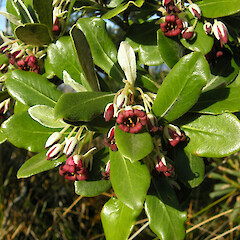Pittosporum crassifolium
Common name
karo
Synonyms
Pittosporum crassifolium var. strictum Kirk
Family
Pittosporaceae
Flora category
Vascular – Native
Endemic taxon
Yes
Endemic genus
No
Endemic family
No
Structural class
Trees & Shrubs - Dicotyledons
NVS code
The National Vegetation Survey (NVS) Databank is a physical archive and electronic databank containing records of over 94,000 vegetation survey plots - including data from over 19,000 permanent plots. NVS maintains a standard set of species code abbreviations that correspond to standard scientific plant names from the Ngä Tipu o Aotearoa - New Zealand Plants database.
PITCRF
Chromosome number
2n = 24
Current conservation status
The conservation status of all known New Zealand vascular plant taxa at the rank of species and below were reassessed in 2017 using the New Zealand Threat Classification System (NZTCS) – more information about this can be found on the NZTCS website. This report includes a statistical summary and brief notes on changes since 2012 and replaces all previous NZTCS lists for vascular plants.
Please note, threat classifications are often suggested by authors when publications fall between NZTCS assessment periods – an interim threat classification status has not been assessed by the NZTCS panel.
- Conservation status of New Zealand indigenous vascular plants, 2017 . 2018. Peter J. de Lange, Jeremy R. Rolfe, John W. Barkla, Shannel P. Courtney, Paul D. Champion, Leon R. Perrie, Sarah M. Beadel, Kerry A. Ford, Ilse Breitwieser, Ines Schönberger, Rowan Hindmarsh-Walls, Peter B. Heenan and Kate Ladley. Department of Conservation. Source: NZTCS and licensed by DOC for reuse under the Creative Commons Attribution 4.0 International licence.
2017 | Not Threatened
Previous conservation statuses
2012 | Not Threatened
2009 | Not Threatened
2004 | Not Threatened
Brief description
Bushy small tree with greyish leathery oval leaves that are white underneath and clusters of small dark red flowers and large hard green fuzzy capsules inhabiting upper North Island. Leaves 5-7cm long, margins often rolled under. Fruit 2-3cm wide, splitting into three to display the black seeds in a yellow pith.
Distribution
Endemic. New Zealand, Great Barrier and North Island. In the North indigenous from Te Paki south to about White Cliffs, and East Cape. Widely naturalised further south to Wellington. Naturalised in the South, Stewart and Chatham Islands. Also naturalised on Norfolk Island, and in Hawaii.
Habitat
Coastal and offshore islands. Favouring steep slopes, cliff faces, boudler beaches, rock stacks and the margins of petrel burrowed land. Sometimes forms major canopy dominant on offshore islands, and on occasion can be a significant component of dune forest. Often an urban weed because its fruits/seeds are avidly taken by indigenous and exotic birds and dispersed widely.
Detailed description
Gynodioecious shrubs to small trees 1-10 m tall. Trunk stout, grey-black. often distinctly lenticillate. Branches and branchlets erect, dark grey-black or brown, immature branchlets densely invested in grey-white or white tomentum, this maturing black. Leaves alternate, usually densely crowded toward branch and branchlet apices. Petioles 4-14 x 1-3 mm, grey-white to grey-black tomentose. Leaves 30-100 x 10-30 mm, obovate to oblanceolate, apices obtuse to acute, base attenuate, margins entire, both surfaces densely white, grey-white or brown tomentose when young, soon glabrate above but remainly densely covered in dirty white or grey-white, appressed tomentum beneath, very coriaceous, margins thickened and often strongly revolute, surfaces often blistered with insect galls. Flowers in terminal 1-10-flowered fascicles; pedicels 6-50 mm, accrescent in fruit, tomentose, subtended by a whorl of leaves and numerous, 3-15 mm long, caducous, brown-tomentose, ciliate bud scales. Sepals 7-11 x 1.5-3 mm, oblong to linear-lanceolate, acute, greyish-white, dirty white or brown tomentose on outer surfaces, inner surface only toward the middle, margins ciliate. Petals 10-16 x 3-5 mm, oblanceolate to lanceolate, subacute, free to base, recurved at apices, dark red, purple, yellow, pink or white; stamens 5-9 mm long, anthers 1-3 x 0.5-1.5 mm, sagittiform to elliptic-oblong. Ovary 3-6 x 2-5 mm, white or grey-white tomentose; style 3-2.5 mm long, stigma capitate or 3-lobed truncate. Capsules woody, 10-30 x 10-30 mm, (2-)3(-4)-valved, woody, trigonous, sometimes 2-4-lobed
Similar taxa
Pittosporum fairchildii Cheeseman is somewhat similar, differing from P. crassifolium by its glabrate rather than heavily tomentose foliage and capsules, both being sparsely covered in brownish tomentum. Furthermore the capsules of P. fairchildii are green to yellow-green rather than grey-black when mature, somewhat fleshy rather than woody, sparsely covered in brown tomentum rather than densely covered in grey-white tomentum and unlike P. crassifolium they scarcely (if ever) open, tending to fall intact from the tree.
Flowering
August - October
Flower colours
Red/Pink, Violet/Purple
Fruiting
September - August (Old fruits persist on trees)
Propagation technique
Easy from fresh seed. Often appears spontaneously in gardens as the seed is distributed far and wide by exotic and indigenous birds. An attractive species popular for its fast growth, robust grey-green leaves, sweetly scented flowers and remarkable resilience in coastal areas. Although frost sensitive, once established it will tolerate moderate frosts and snow fall.
Threats
Not Threatened. However, the fruits are eaten by rats, and on rodent infested offshore islands this species rarely regenerates.
Etymology
pittosporum: Pitch seed
crassifolium: From the Latin crassus’ thick and folius ‘leaf’
Where To Buy
Commonly available from most garden centres.
Taxonomic Notes
Plants referred to this species from Raoul Island, in the Kermadecs are an as yet undescribed species, perhaps closest to the Norfolk Island Pittosporum bracteolatum Endl. The type of P. crassifolium appears to be the same as the later named Pittosporum ralphii Kirk. Further research is needed.
Attribution
Fact sheet prepared for NZPCN by P.J. de Lange 30 August 2006. Description adapted from Cooper (1956).
References and further reading
Cooper, R.C. 1956: The Australian and New Zealand species of Pittosporum. Annals of the Missouri Botanical Garden 43: 87-188
NZPCN Fact Sheet citation
Please cite as: de Lange, P.J. (Year at time of access): Pittosporum crassifolium Fact Sheet (content continuously updated). New Zealand Plant Conservation Network. https://www.nzpcn.org.nz/flora/species/pittosporum-crassifolium/ (Date website was queried)























